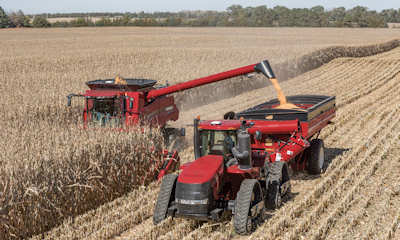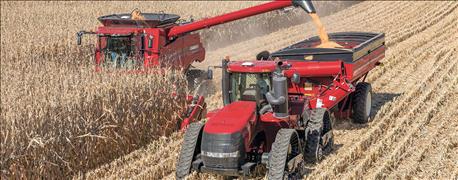
As harvesttime approaches and the growing season comes to a close, it’s a perfect time for growers to start the process of reflecting not only on what went right this year, but also on what didn’t go so well.
This is especially important when it comes to evaluating your control program with an eye toward improvement in 2016.
Weed control has become a year-round chore. Not convinced? Ask a grower in any place around the country where herbicide-resistant weed infestations are a problem.

EARLY WEED CONTROL: A ride in the combine at harvest is a great time to evaluate weed control in 2015 and plan for 2016, and advanced mapping tools allow you to note weed infestations for later examination.
“We have been talking about resistant marestail management since 2000, but it was a rather new problem at the time, so not many growers were preparing for it,” says Dwight Lingenfelter, a weed scientist with Penn State Extension, explaining one of the things he’s currently seeing happen in Pennsylvania. “Now that many farms have a problem with marestail, the urgency to control it is finally real to them, so growers [want] answers, even though we have been talking about it for over a decade.”
The above scenario happens across the country today as growers continue to be challenged by a host of weed-related issues — all of which can have a direct impact on yields and the bottom line. Given this, Lingenfelter says growers need to begin next year’s weed control efforts now in order to protect their future crop yields.
“With more weed species developing resistance, it’s very important to monitor any new infestations and plan your management tactics accordingly,” he says. “Make sure to scout fields to actually see what’s happening, and look for certain patterns or weed shifts that are occurring.”
Beyond scouting
Besides conducting field scouting to determine how your 2015 weed control programs performed, Lingenfelter believes looking at other practices to help combat weeds is also important.
“Think about ways to incorporate other practical weed management tactics, like cover crops, or other good agronomic practices, such as soil fertility, selecting the best crop varieties for your location and planting dense crop populations at the proper time,” suggests Lingenfelter, who cautions that careful planning is required because various tactics can sometimes conflict with one another (e.g., fall cover crop establishment may be hindered by the use of longer-residual herbicides in the cash crop, or the utility of fall burndown herbicides can be limited if cover crops are planted).
Bottom line, whether or not you try alternative tactics, using different modes of action and providing overlapping layers of residual herbicides throughout the season are critical steps in any successful weed control program, Lingenfelter says. He also stresses that if resistant weeds — like Palmer amaranth and waterhemp — are not dealt with in the early stages, prior to infestation, and are allowed to spread across fields, eradicating the problem can be very costly over the long run.
Kevin Bradley, an associate professor in the University of Missouri’s Division of Plant Sciences, also reiterates the importance of starting early in your weed control efforts.
“It’s pretty intuitive for most growers today, but a good time to evaluate your fields is when you’re in the combine during harvest,” offers Bradley, who says making mental notes and even physical maps of places where weed pressure is occurring is an important part of the process.
However, Bradley also knows economics (or the bottom line) is an important, determining factor in the weed control decisions made by growers every year. More precisely, he believes yield is the critical factor and the “No. 1 determinant” of every decision growers make.
“It’s all economics. For example, if you don’t apply a fall herbicide, it means you can use more money on your spring herbicide program,” says Bradley, who estimates at least 90% of Missouri’s acres receive a preemergence, residual herbicide because of resistant waterhemp. “All of this needs to be balanced out, but most growers have some dollar figure in mind when it comes to what they’re willing to spend on weed management each year.”
Given this, Bradley says there are many different ways for growers to spend their money on weed control efforts, but how they decide to proceed will (and should) be based on the specific needs and individual characteristics of each field.
While there are some alternative tactics on the distant horizon (see story below) overlooking what needs to be done now is ill-advised, especially given the growing problems associated with herbicide-resistant weeds. This is why Bradley says a proactive approach to next year’s weed control efforts is recommended.
“Right now is the time to plan for 2016,” offers Bradley. “You have to plan, plan, plan, because whatever happened this year, you want to make sure it isn’t worse next year.”
Zero tolerance
Likewise, Randall Currie, an associate professor of weed science at Kansas State University, says scouting your fields this fall is an important first step, but so is engaging outside help to devise a plan for 2016.
“Scout your fields and see where you’re at and what you missed and where ... and write it down,” says Currie. “If you don’t know what the weed is, find out while you can, and get a good sample, because this is the time of year where you have some wiggle room and time to ID the problem.”
Once again, all of these recommended steps rely upon growers being proactive and devoting the time needed to address any weed-related problems. And, rest assured, ending 2015 on a good note will help get your 2016 weed control efforts headed down the right path.
Yontz writes from Urbandale, Iowa.
A different approach to weeds
The University of Missouri’s Kevin Bradley believes new weed control tactics are also on the horizon, though it may take some time before they are accepted and put into practice. One example he cites is “harvest weed seed management,” which is used a lot in Australia. In short, the goal of harvest weed seed management is to reduce the number of weed seeds that go back into the soil. This is accomplished by using special equipment that essentially neutralizes weed seeds and keeps them from going through the combine and back into the ground.
“Harvest weed seed management is currently being researched in the United States. It’s probably years away from being commonplace here, but I’d expect to see something like this in our future,” says Bradley.
Harvest weed seed management certainly represents a possible tool in the future arsenal for combating weeds.
Solution Center is independently produced by Penton Agriculture through support from SureStart® II herbicide. For more information, visit GetMoreTime.com.
About the Author(s)
You May Also Like




